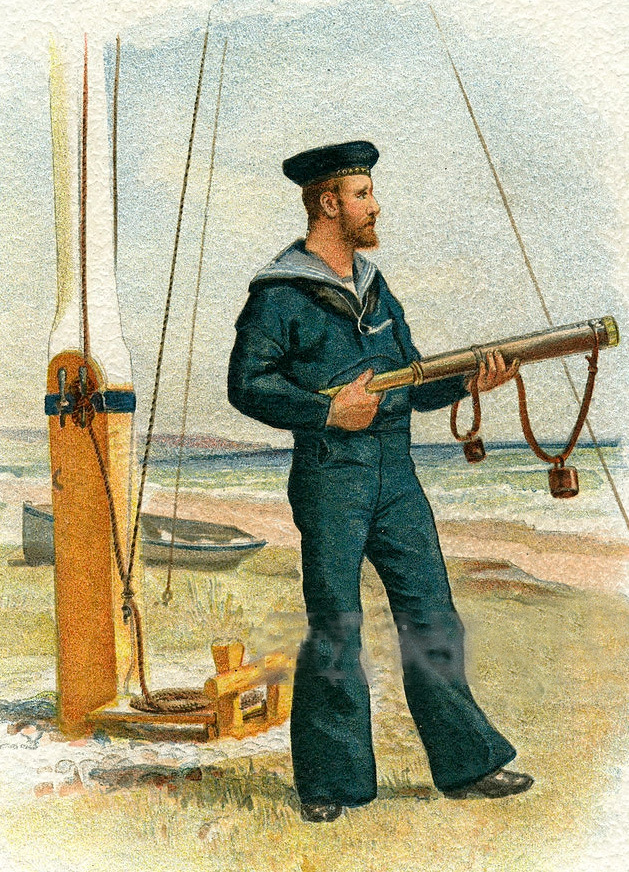
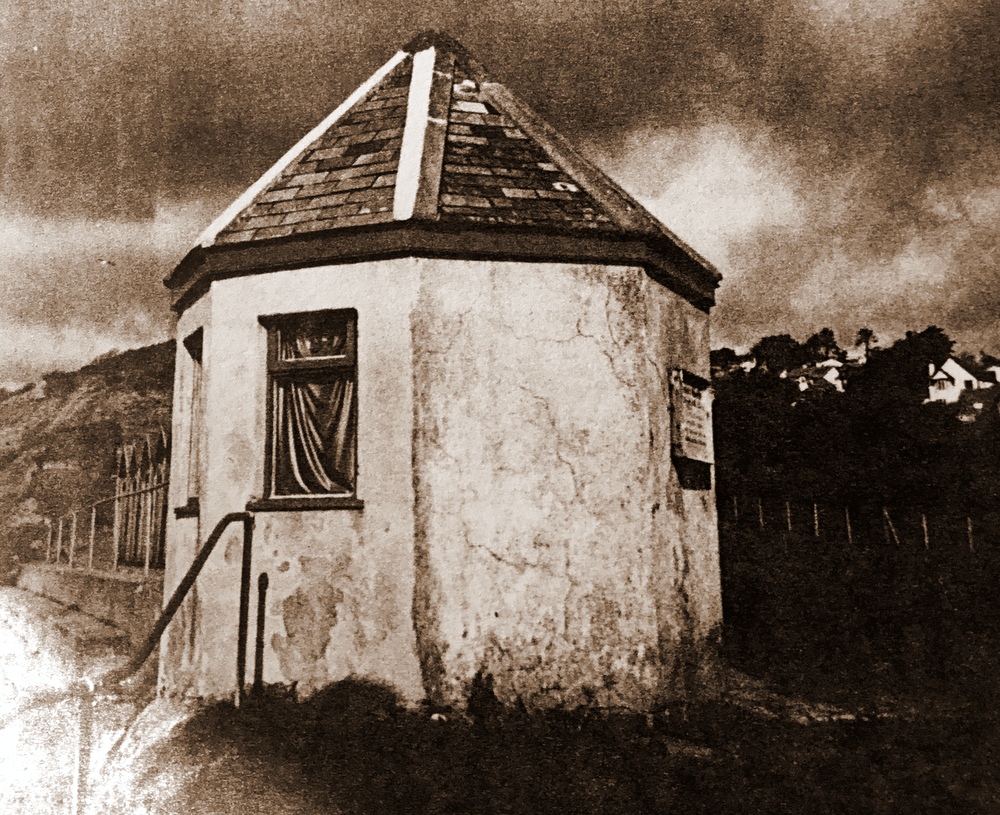
History of the Lookout
Visitors to Charmouth are also often puzzled by an unusual, octagonal-shaped building which stands on the crumbling edge of a low cliff above the foreshore and beach, near the mouth of the river Char. The walls are of the soft local stone, and have been rendered as a protection against the weather. There is a timber door on the more sheltered landward side, and windows are set in the three seaward walls - one facing south-east to command a view along the Chesil Beach and towards the Isle of Portland; another facing south across Lyme Bay and out to the Channel; and the third facing south-west towards the Cobb harbour at Lyme Regis. This unusual building is The Lookout'.
It was built by the Customs & Excise Service in 1804, at a time when England took the threat of a Napoleonic invasion very seriously. The south-east coasts were the ones thought to be most at risk from a sally by the French from their great port at Boulogne, but in addition to the redoubling of vigilance at the Cinque Ports, preparations were made all the way along the south and south-west coasts. An observation and warning system of lookout and signal posts was established at prominent points along the shoreline, together with beacons on the highest hills inland, all designed to enable invasion warnings to be flashed across the country with great speed and- urgency. The invasion, however, never came.
Nevertheless, smuggling had for some time been rife along this coastline and, during the first half of the 19th century, the Lookout was used very effectively by the Excise & Coastguard Service in their endeavours to intercept the running of brandy from France, and to apprehend the smugglers. There is still a sunken lane running inland from the eastern cliffs of Charmouth which retains its earlier name of the Smugglers' Path. The Western Flying Post reported that one Saturday night in January 1825, three men of the Lyme Preventive Station were on the look-out near the mouth of the Charmouth river, where they captured 150 kegs and two men. But they were then discovered and attacked by 70-80 drunken smugglers who, in the struggle that followed, made off again with most of the brandy, leaving behind three of their number who subsequently served three months in Dorchester gaol. The registers of Dorchester gaol recorded similar imprisonments of Charmouth smugglers, including 21 year old Elizabeth Powell in 1824, and a 49 year old seaman, Henry Tippen, in 1828.
In 1856, the Excise & Coastguard Services were formally taken over by the Admiralty, who continued to rent the Lookout and its adjacent flagstaff from the lord of the manor for £3 a year. In 1909, the use of the Lookout as an observation post was discontinued, and in 1945 the building was given to Charmouth Parish Council. In 1989, it was designated as a Grade II listed building by the Department of the Environment.
1803 May 18: Britain declares war on France.
1804 Look Out built

Napoleon needed peace with the UK to implement the Treaty of San Ildefonso and take possession of Louisiana. Otherwise, Louisiana would be an easy prey for the UK or even for the United States. But in early 1803, continuing war between France and the UK seemed unavoidable. On March 11, 1803, Napoleon began preparing to invade the UK.
As Napoleon had failed to re-enslave the emancipated population of Haiti, he abandoned his plans to rebuild France's New World empire. Without sufficient revenues from sugar colonies in the Caribbean, Louisiana had little value to him. Spain had not yet completed the transfer of Louisiana to France, and war between France and the UK was imminent. Out of anger against Spain and the unique opportunity to sell something that was useless and not truly his yet, Napoleon decided to sell the entire territory.[12]
Although the foreign minister Talleyrand opposed the plan, on April 10, 1803, Napoleon told the Treasury Minister François de Barbé-Marbois that he was considering selling the entire Louisiana Territory to the United States. On April 11, 1803, just days before Monroe's arrival, Barbé-Marbois offered Livingston all of Louisiana for $15 million, equivalent to about $233 million in 2011 dollars[13] which averages to less than three cents per acre.[14][15]
The American representatives were prepared to pay up to $10 million for New Orleans and its environs, but were dumbfounded when the vastly larger territory was offered for $15 million. Jefferson had authorized Livingston only to purchase New Orleans. However, Livingston was certain that the United States would accept the offer.[16]
The Americans thought that Napoleon might withdraw the offer at any time, preventing the United States from acquiring New Orleans, so they agreed and signed the Louisiana Purchase Treaty on April 30, 1803. On July 4, 1803, the treaty reached Washington, D.C.. The Louisiana Territory was vast, stretching from the Gulf of Mexico in the south to Rupert's Land in the north, and from the Mississippi River in the east to the Rocky Mountains in the west. Acquiring the territory would double the size of the United States, at a sum of less than 3 cents per acre.The American government used $3 million in gold as a down payment, and issued bonds for the balance to pay France for the purchase. Earlier that year, Francis Baring and Company of London had become the U.S. government's official banking agent in London. Because of this favored position, the U.S. asked the Baring firm to handle the transaction. Francis Baring's son Alexander was in Paris at the time and helped in the negotiations.[38] Another Baring advantage was a close relationship with Hope and Company of Amsterdam. The two banking houses worked together to facilitate and underwrite the Purchase.
Because Napoleon wanted to receive his money as quickly as possible, the two firms received the American bonds and shipped the gold to France.[38] Napoleon used the money to finance his planned invasion of England, which never took place.[39]
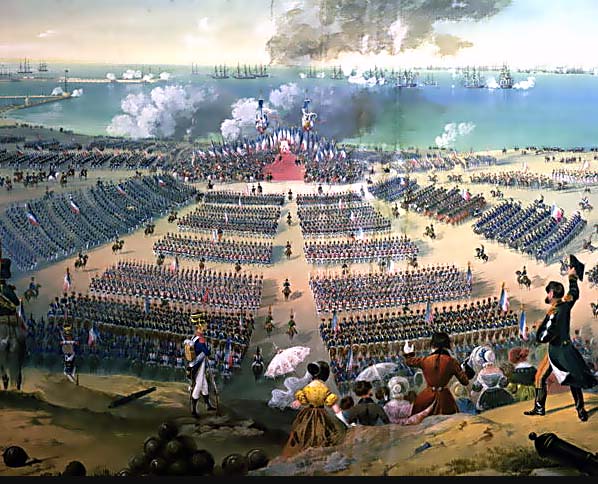
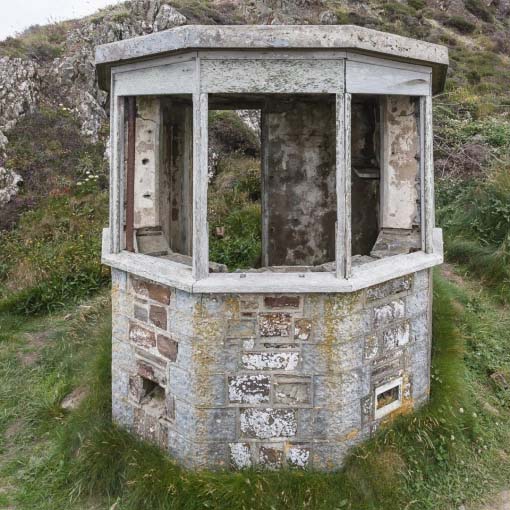
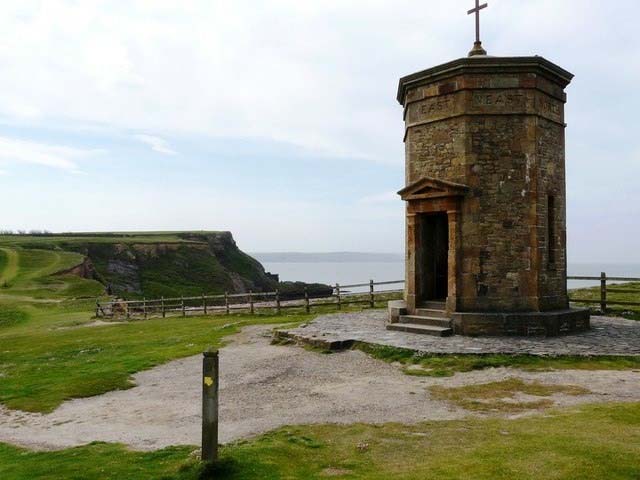
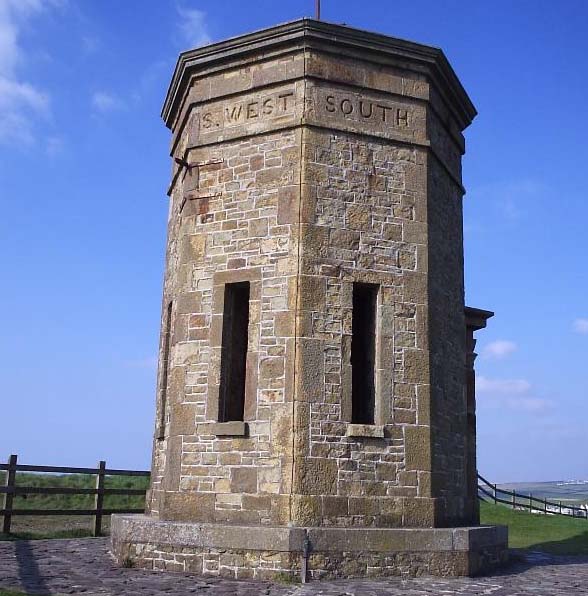
lookout tower at Compass Point, Bude
This tower would have been used for the coast guard to watch the
sea and cliffs.
The tower is situated on a cliff-top hill, there are 2 steps up into the tower, otherwise you are on ground level. No extra height is needed. Compass Point is the small tower seen on the cliffs, originally a coastguard lookout and based on the ‘Temple of Winds’ in Athens; having eight sides it is known locally as The Pepper Pot.
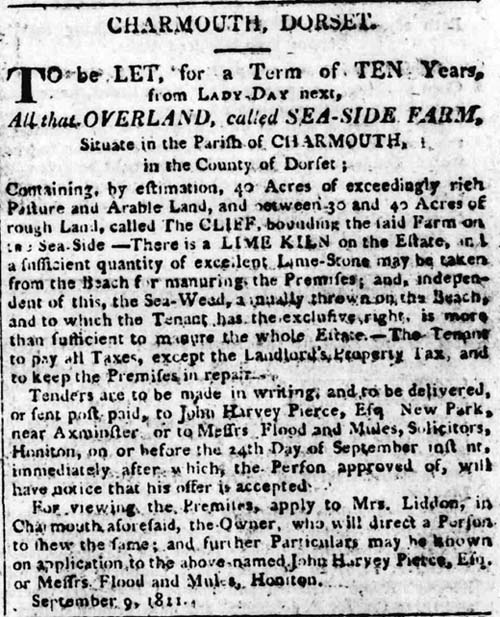
Charmouth, Dorset
To be Let, for a Term of Ten Years from Lady Day next.
All that Overland, called Sea - Side Farm,situate in the Parish of Charmouth, in the County of Dorset. Containing by estimation, 40 Acres of exceedingly rich Pasture and Arable Land, and between 30 and 40 Acres of Rough Land, called the Cliff, bounding the said Farm on the Sea-Side - There is a Lime Kiln on the Estate, and a sufficient quantity of excellent Lime-Stone may be taken from the Beach for manuring the premises, and, independent of this, the Sea Weed, annually thrown on the Beach, and to which the tenant, has the exclusive right is more than sufficient to manure the whole Estate. - The Tenant to pay all the Taxes, except the Landlords Property Tax and to keep the Premises in repair.
Tenders are to be made in writing, and to be delivered, or sent post-paid, to John Harvey Pierce, Esq. New Park, Near Axminster, or to messrs. Flood and Mules, Solicitors, Honiton, on or before the 24th day of September inst. and immediately after which, the Person approved of, will have notice that his offer is accepted.
For viewing the Premises, Apply to Mrs. Liddon, in Charmouth aforesaid, the Owner, who will direct a Person to show the same, and further Particulars may be known on application to the above named John Harvey Pierce Esq. or Messrs. flood and Mule, Honiton. September 9, 1811.
On the night of Saturday week, three men of the Lyme Preventive Station were on the look-out near the mouth of the Charmouth River, where they captured 150 kegs and two men. They had not retained possession long before they were attacked by a party of smugglers 70 or 80 in number and as is usual in such adventures they appeared affected by liquor. They advanced with great violence. In defence, the officers were compelled to fire in the midst of them, in consequence of which, one man fell and was carried off by the party, who immediately retreated carrying with them all but 10 kegs and the two prisoners. One of the officers named Davis was mistaken for his brother, an extremely active man stationed near Bridport and nothing short of murder was intended towards him, as an attempt was made to cut his throat, which did not take effect, as the stock in his cravat prevented the weapon from making any serious incision. The smugglers continued to discharge large stones from the cliff upon the Revenue men who, though they were preserved by the darkness of the night from destruction, received some severe contusions, and are now confined in consequence." 31st January 1825
The Manorial Rights over the Foreshore
Until 1938, when it was acquired by Charmouth Parish Concil, the beach belonged to the Lords of the Manor of Charmouth. Some time before 1320, the Abbot of Ford owned the manorial rights, which he retained until the Abbey was dissolved.
In 1554 Queen Elizabeth gave the Manor to Robert and William Caldwell, who sold it in he same year to Sir John William Petre, his son John, conveyed it to the Poles, and in 1649 it was bought by William Ellesdon, of Lyme Regis. The Manor remained in the Ellesdon family until it was purchased at the end of he 18th century by James Warden, his grandson Matthew Liddon, sold it to John Hawkshaw, from who it passed to J.J. Coulton, who sold it to Alfred Capper Pass. Queen Elizabeth, by a charter, granted to the Lords of the Manor the same rights enjoyed by the Abbots of Ford, together with the tenements, messuages, mills, dove-houses, lands, marshes, waters, fishery, etc.
The foreshore stretched from the boundary of Hawkswood to that of Lyme Regis. In 1674 William Ellesdon, for the annual rent of 6d granted permission to he Mayor of Lyme Regis to take stone and sand from Charmouth beach. A similar license was granted to he owner of Wootton Fitzpaine, Thomas Rose Drew. In 1778 Benedicta Durston, the last of he Ellesdon family to hold the Manor ..... In consideration of a good road made in the lane leading to the sea at the cost and expense of the Parishioners, renounced to the Parish all the rights and titles to the lane, with all wrecks, stone, sand, and sea weed during her life time.
After her death, and after James Warden had purchased the Manor, the parishioners still continued to take stone and sea weed from the beach, and they even held a Vestry Meeting on the 13th April 1789, at which they claimed that their ancestors had enjoyed that right from time immemorial. Those present at the Meeting agreed to defend their rights and to defray the charges by a parish rate. This was signed by the Rev. Brian combe and two others. Immediately James Warden brought an action of Trespass against Rev. Brian Combe and others for entering a close belonging to the Manor, and for carrying away stones, sea weed and sand. Warden won his case, and hereby established his rights to the beach as Lord of the Manor. Another act of trespass was committed by James Gerrard, who was presented at the Court Leat on the 28th October, 1808 for taking sand and stone. He last case was bought in 1896, when J.J.Coulton won an action against a Trespasser for removing sand and shingle.Since than, a Royalty on all sand etc, as well as tent for bathing tents and huts, has been paid to the Lord of the Manor.
The Liddons finally decide to sell The Manor of Charmouth and George Frean, aged 61 and his son George Hender Frean, who originate from Plymouth pay £6500 for it. The family have prospered and George senior is shown as Mayor of the town at one time. They are described as corn merchants and operate a number of mills in the Plymouth neighbourhood. In 1844 George had formed the Plymouth and Dartmoor Gunpowder Company near Postbridge, The gunpowder was in great demand for both quarrying and for farmers clearing rock from their land.
It is difficult to reason why he was to pay such a large sum for the Charmouth Manor Estate, but in the end it proved a good investment. Before the year was out he was to sell off Langmoor Manor from it to Ann Farwell Moly for £3400 and a parcel of fields to John Wilcocks for £2000. His name rarely appears in the records of Charmouth, for at this time the Censuses show him living in Drakes Place in Plymouth with his family. But one interesting piece of information is a Census record showing that his son John Fender Frean between 1856 and 1858 had 3 children one being born in Lyme Regis and the other two in Charmouth.. Harrods Directory for1855 describes George Frean as the Lord of the Manor and its main landowner. The deeds for the Manor of Charmouth show that he borrowed heavily against its value and by 1863 owed £3750. When it was eventually sold, his son George Hender Frean benefits from the sale and it no doubt helped with the finance of his other business, for he was the co-founder of the world famous biscuit firm - Peek Freans.
It is worthwhile studying the connections with the firm as there is a direct link in the neighbourhood with the other part of the name - Peek. For in 1871 Sir Henry Peek, M.P. for Mid Surrey established his Estate at Rousdon, near Lyme Regis. His father was James Peek who had run a successful Tea Importers in London and in 1857 wished to diversify after his sons refused to join the family business. He decided to set up a new business and contacted George Hender Frean who had married Hannah Peek, one of his nieces. Peek wrote to him explaining he would set up a biscuit factory for his sons if Frean would manager and partner, he accepted. Sadly it did not work out for the sons, but Peek Freans was to prosper under George Frean.
George Freans main focus was the setting up of a Cement Works near the existing Lime Kilns by the mouth of the River Char and the sea. His sister, Anna Frean had married Michael Morcom, described as a Mine Agent and was to have ten children. No doubt with a background in quarrying he was ideal for running a Cement Factory for George. By January 7th, 1863 the building we see today had been finished by the local builders, Pryers and a later auction catalogue reveals that Mr. Morcom of Plymouth had a 21 year lease and was paying £100 a year rent for it. But sadly the business never took off and may well have contributed to George Frean`s decision to sell his Estate to John Hawkshaw on January 1 1864 for £6000. This was precisely 10 years from the day he had bought his property in Charmouth from the Liddons.
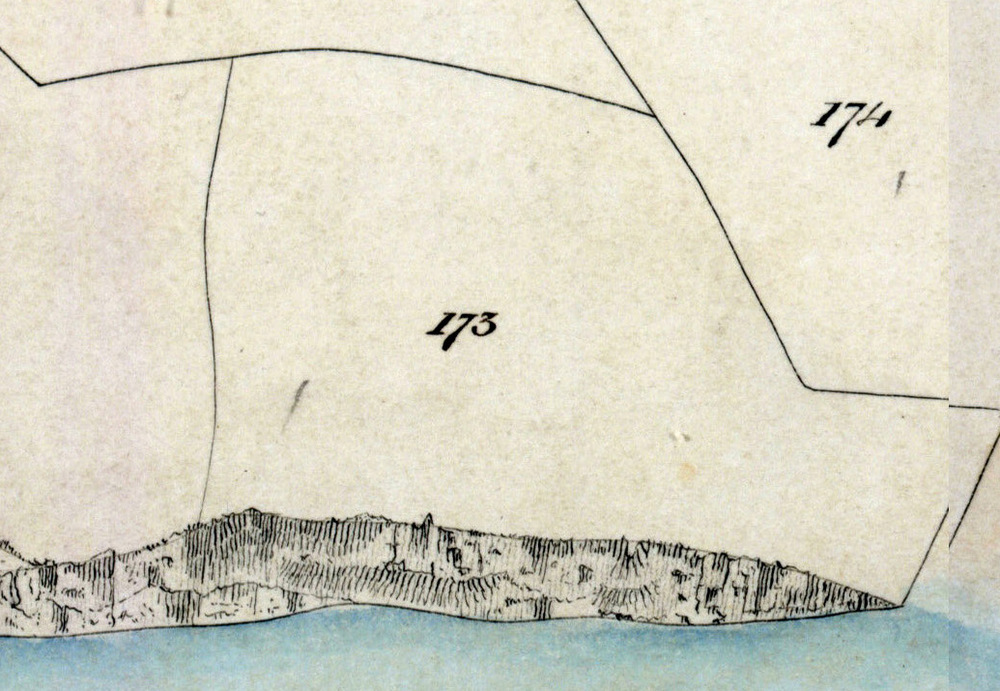
In the 1841 Election for an M.P. for Lyme Regi, Charmouth is included in the Voting. But there are suspicions of bad practices and a Commission is set up at Westminster to look into it. The record of this can be read in Volume 6 of "Reports of cases of controverted elections in the fourteenth parliament". A lime kiln at Charmouth was used to secure a vote in one of the Lyme Regis Constituency’s famously disputed Parliamentary elections. The investigating Parliamentary Select Committee had to have it explained to them what a lime kiln was. On learning that it was open to the sky and uninhabitable they ruled that it did not qualify as a house worth the required sum and therefore should not have enfranchised its owner or person falsely claiming to occupy it. The surveyor who assessed the value of the property had been bribed to value the kiln as if it were a house worth more than the threshold value for enfranchisement. The vote was struck off, as was a similar vote “enfranchised” by ownership of a pig sty by James Powell, but these were not then criminal actions, so no prosecutions were launched.Pinney was initially declared re-elected at the general election of 1841, but on petition his election was declared void and Hussey declared elected in his place after scrutiny of the votes.
The entrepeneur, George Frean main focus must have been the setting up of a Cement Works near the existing Lime Kilns by the mouth of the River Char and the sea. His sister, Anna Frean had married Michael Morcom, described as a merchant at Plymouth in 1836. They were to have ten children. One of whom - George Frean Morcom was to later reside in Los Angles and become world famous as an Ornithologist. But in 1851, the family are living at St Agnes in Cornwall and Michael is described as a Mine Agent. No doubt with a background in quarrying the Morcoms would be ideal for running a Cement Factory for George. By January 7 th , 1863 the building we see today had been finished by the local builders, Pryers and a later auction catalogue reveals that Mr. Morcom of Plymouth had a 21 year lease and was paying £100 a year rent for a Cement Mill, a Stone and Slated Building, with two floors, lean to, and two kilns. On top of the rent there were royalties of 1s 6d per ton on Cement,1s per ton on unmanufactured Stone,1s per ton on Manganese, and 2s per 1000 on all Bricks,Tiles and other like articles manufactured by the Lessee. But sadly the business never took off and may well have contributed to George Frean`s decision to sell his Estate to John Hawkshaw on January 1 1864 for £6000. This was precisely 10 years from the day he had bought his property in Charmouth from the Liddons. So ended an interesting chapter in Charmouth`s history which few people would be aware of . It does explain why the Cement Works came to be built. In its day, a white elephant due to its size, but now an important resource for the promotion of the Town.
The Factory was built for grinding the lime stones found on the beach for the manufacture of cement. It consisted of a large room facing east with double doors and a small office just inside on the left. Opposite the entrance was a doorway leading into the engine room and to the "boiler room. The engine was a small beam engine with a large fly wheel, by the side of which was another door leading to a room containing machinery, which is now used for storing deck chairs in winter, There were two other compartments, probably store rooms, one with a door by the side of that leading to the engine room and the other with an entrance from the yard outside on the west side* Opposite this door and built into the west cliff were two lime kilns. The boiler room had a tall chimney, which for many years was a very useful guide for fishermen for locating their fishing grounds. There were no doors or windows facing the sea,, The two store rooms are now part of the beach cafe. The upper floor was reached by outside stone steps in the N.W. corner - since demolished - and by an inside wooden ladder. The machinery was mounted on firm foundations probably used for grinding."The stones were brought to the kilns by horse and cart and smaller stones, known as washers were collected by women. There were two women to a basket and they received 3d a basket, and they did very well especially after a S.W. gale when tons of Washers were brought by the gale quite close to the factory. The basket held 40 lbs.
There is no record that it was ever worked again.For several years it remained derelict. Fishermen kept their boats and lobster pots in winter in the large room. Boy Scouts made it their Head Quarters and the upper floor was used for a miniature rifle range. The roof lost many slates and at one time the store room, which is now the cafe, was open to the skies. The engine and what remained of the machinery were removed in or about 1920. It remained Manor property until it was sold to Charmouth Parish Council with the foreshore in 1938.
The Liddons finally decide to sell The Manor of Charmouth with Langmoor House which together with meadows is almost 100 acres, by Auction at the Auction Mart, Bartholomew lane in London on Thursday 18th August 1853.It is then bought by George Frean, aged 61 and his son George Henderson Frean, who originate from Plymouth for £6500. The family have prospered and George senior is shown as Mayor of the town at one time. They are described as corn merchants and operate a number of mills in the Plymouth neighbourhood and are shown living by Drakes Place Mill in the town. In 1844 George had formed the Plymouth and Dartmoor Gunpowder Company near Postbridge, Dartmoor. Its Production started in 1844 after he had spent £12000 on the venture. The gunpowder was in great demand for both quarrying and for farmers clearing rock from their land. Over a hundred people were employed and it prospered until the invention of dynamite in 1867 when demand fell dramatically. George Frean retired in 1885 after selling this business.
It is difficult to reason why he was to pay such a large sum for the Charmouth Manor Estate, but in the end it proved a good investment. Before the year was out he was to sell off Langmoor Manor from it to Ann Farwell Moly for £3400 and a parcel of fields to John Wilcocks for £2000. His name rarely appears in the records of Charmouth, for at this time the Censuses show him living in Drakes Place in Plymouth with his family. But one interesting piece of information is a 1861 Census showing that his son John Fender Frean between 1856 and 1858 had 3 children one being born in Lyme Regis and the other two in Charmouth.But by the 1861Census he has returned back to Plymouth. He no doubt lived in one of his fathers houses in the village, but it is difficult to pinpoint precisely which one for this short period. Harrods Directory for1855 describes George Frean as the Lord of the Manor and the main land owner. There is another reference to George being paid a rent of £3 a year by the Excise men who occupied the cliff slope immediately west of the Cement Factory. Here they had built the little octagonal lookout, which still stands on the Manor land. The deeds for the Manor of Charmouth show that he borrowed heavily against it's value and by 1863 owed £3750. When it was eventually sold,his son George Hender Frean is shown as benefiting from the sale and it no doubt helped with the finance of his other business. For his claim to fame is that he was one of the co-founder of the world famous biscuit firm - Peek Freans.
It is worthwhile studying the connections with the firm as there is a direct link in the neighbourhood with the other part of the name -Peek. For in 1871 Sir Henry Peek, M.P. For Mid Surrey established his Estate at Rousdon, near Lyme Regis. His father was James Peek who had run a successful Tea Importers in London and in 1857 wished to diversify after his sons refused to join the family business. He decided to set up a new business and contacted George Hender Frean, a miller and ships biscuit maker who had married Hannah Peek, one of his nieces. Peek wrote to him explaining he would set up a biscuit factory for his sons if Frean would manager and partner, he accepted. Sadly it did not work out for the sons , but Peek Freans was to prosper under George Frean. He went on to contact an old school friend, John Carr who had a background in biscuit manufacture and was to develop the famous Pearl biscuit, which was the pioneer of the biscuit we know today. In 1866 they had outgrown their former premises and built a huge factory in Bermondsey which continued to be a major employer in the area until it closed down in 1989. Celebrated lines invented by Peek Freans were: Garibaldi(1861) ,Maria (1875),golden puff,(1909),bourbon(1910).shortcake(1912),cheeselets and Twiglets.
I have pondered over why George Frean attended the Auction in London when the Charmouth Estate came up in 1853. His background shows him as a successful entrepreneur willing to create a business from nothing as he no doubt was able to do with the gunpowder factory he set up on Dartmoor. He obviously was not that interested in Langmoor Manor as a house to live in, as he was soon to sell that it off and then went on to sell part of the farm very quickly to raise money. He used what remained as an asset to borrow against. His main focus must have been the setting up of a Cement Works near the existing Lime Kilns by the mouth of the River Char and the sea. His sister, Anna Frean had married Michael Morcom, described as a merchant at Plymouth in 1836. They were to have ten children. One of whom - George Frean Morcom was to later reside in Los Angles and become world famous as an Ornithologist. But in 1851, the family are living at St Agnes in Cornwall and Michael is described as a Mine Agent. No doubt with a background in quarrying the Morcoms would be ideal for running a Cement Factory for George. By January 7 th , 1863 the building we see today had been finished by the local builders, Pryers and a later auction catalogue reveals that Mr. Morcom of Plymouth had a 21 year lease and was paying £100 a year rent for a Cement Mill, a Stone and Slated Building, with two floors, lean to, and two kilns. On top of the rent there were royalties of 1s 6d per ton on Cement,1s per ton on unmanufactured Stone,1s per ton on Manganese, and 2s per 1000 on all Bricks,Tiles and other like articles manufactured by the Lessee. But sadly the business never took off and may well have contributed to George Freans decision to sell his Estate to John Hawkshaw on January 1 1864 for £6000. This was precisely 10 years from the day he had bought his property in Charmouth from the Liddons. So ended an interesting chapter in Charmouth`s history which few people would be aware of . It does explain why the Cement Works came to be built. In its day, a white elephant due to its size, but now an important resource for the promotion of the Town
from the Cement Industry in Lyme Regis.
The Old Cement Mill, Charmouth From about 1850 John Morcombe & Sons, a Plymouth-based enterprise, set up a works at Charmouth to make cement from the Two Cementstones, a part of the Black Ven Marl (Warren 2005). Cement making, from Devonian Limestone, was an old established Plymouth business and hydraulic cement, for which pure Devonian Limestone is unsuitable, was needed for the construction of the Plymouth Breakwater and the Devonport naval dockyard.
The Cement Mill building still exists as the Heritage Centre, right on the shore at the end of Lower Sea Lane, and can clearly be seen as a large white building from Lyme Regis. Some millstones are preserved on the cliff above the centre. The cementstones occur higher up in the Lower Lias sequence than the Blue Lias, which does not outcrop at Charmouth, but they approximate to the best bed once used for hydraulic cement making at Lyme, the West Rock. The Two Cementstones are the cement-grey flat nodules of muddy limestone which can be seen lying on the upper part of the beach on the Lyme side of Charmouth, where they have fallen from higher up in the cliff, where they occur as bands within the mainly mudstone sequence of the Black Ven Marl.
The cementstones were collected from the beach, the larger ones, known as “roundstones” by horse and cart, and the smaller ones by women in pairs, paid 3d (1.25p) per full basket (40lb or 18kg). The stones were taken to the Cement Mill, where they were broken, crushed and mixed with clay got from the cliff before being burnt and the cement clinker ground to a fine powder by granite millstones, two of which are now form the ends to a seat.
Another Plymouth-based enterprise, Hutchinson & Frean took over the Charmouth mill in 1853 and closing it in 1867. It suffered from having no harbour and, from 1855, the large cement works at Lyme was in the same ownership. Cement had to be loaded into flatbottomed boats from the beach, a hazardous operation in which it would be difficult to keep the cement dry. The chimney was demolished about 1900, the building being used as a fishermen’s store, tea room and store for deck chairs and beach tents. Stone and clay removal resulted in more rapid cliff retreat, causing increased landslipping in the 20th century, which is often wrongly blamed on fossil collectors removing supporting material from the cliffs.
The first Lyme Regis Cement Works Production of cement in Lyme started on a large scale in 1855 when Hutchinson & Frean set up their large cement factory at the back of Monmouth Beach to produce hydraulic cement. The Company had started in a smaller way in the area in 1853, taking over the Charmouth Cement Mill from John Morcombe & Co, as explained above. In that year it leased the stone rights west of Lyme to Devonshire Head from the Henley Estate. The first item to be built was a tramway in 1853, shown on Lt Cox and Master Davis’ 1854 Chart of Lyme, no doubt to aid construction of the works. This ran from the Cobb Landing Quay as far west as possible without crossing the actual beach shingle. It eases the movement of stone, cement and, presumably, the delivery of plant. To start the firm started making the bricks on site to build the works and started shipping stone out (see other papers in this series: No. 5 Stone and No. 7 Pottery & Brick).
The company sold up to 120 tons per week of Blue Lias stone, bricks, cement, lime and char (see above advertisement from Roland Brown’s Beauties of Lyme of 1857). Char is similar to ash, but is collected from the flues rather than ash, which collects below the grate. It contains lime and silicates as well as burnt coal, ash and partly-burned coal and coal clinker drawn through by the up draught. It could not be collected from a pot kiln as it would escape with the smoke, suggesting that a more modern forced-draught kiln was being used, for which there is no other evidence. Equally it could have been collected from the boiler flues of the steam engine. Some chars can be used as fertilizer or soil improver, or mixed with cement, to make breeze blocks, but why these chars were sold and how they were used is not known. In the 1890s tonnages of “breeze” were exported from the Cobb by Haycraft (Harbour Dues book 1884-1903).
In 1867 Messrs Harveys of Plymouth took over the works, although initially the takeover cannot have been smooth, as workers had to be laid off until the lease on the western cliffs had been renegotiated, necessitating a public subscription for the men until the spring of 1868 (Dorset County Chronicle, May 1868).
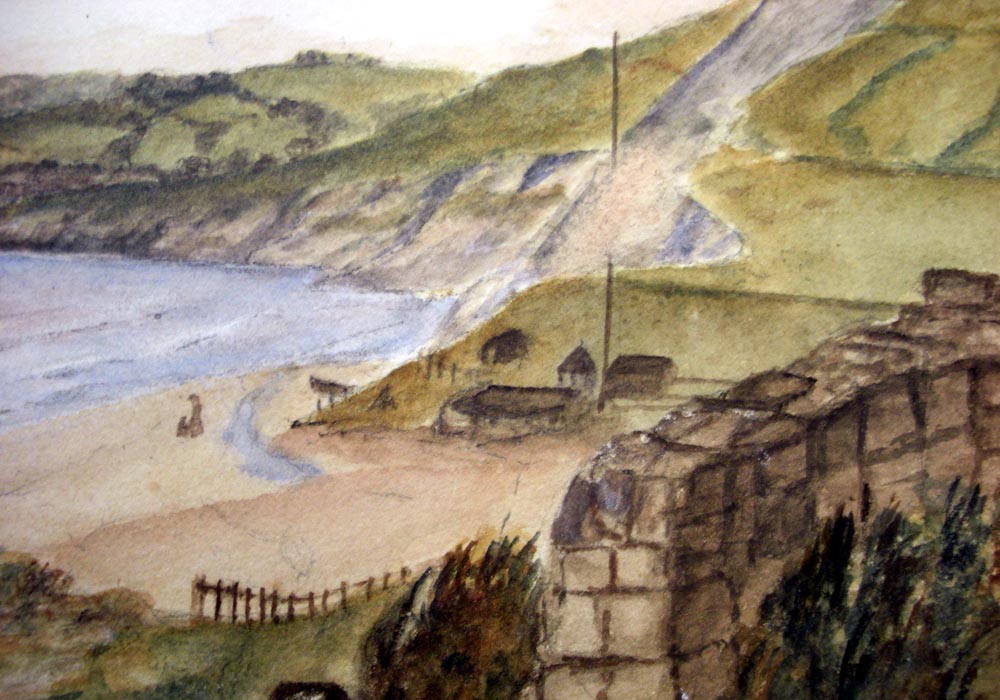
1861 Census for Coast Guards:
5; Coast Gd Station; Joshua CLARK ; Head; M; 30; Coast Gd service; Devon; ; F4P1
5; Coast Gd Station; Harriott CLARK ; Wife; M; 23; Coast Gd wife; Burton; ; F4P1
5; Coast Gd Station; Thomas JERVIS ; Nephew; ; 4; ; Burton Bradstock; ; F4P1
6; Coast Gd Station; Thos. Jervis SNOWDON ; Head; M; 34; Coast Gd service; Devon; ; F4P1
6; Coast Gd Station; Susan Annie Jenny SNOWDON ; Wife; M; 28; Housewife; Devon; ; F4P1
6; Coast Gd Station; Frank Augustus SNOWDON ; Son; ; 17m; ; Charmouth; ; F4P1
7; Coast Gd Station; John LAWLER ; Head; M; 29; Coast Gd Station & Service; Hants; ; F4P1
7; Coast Gd Station; Jane LAWLER ; Wife; M; 26; Housewife; Hants; ; F4P1
7; Coast Gd Station; Mary Jane LAWLER ; Daur; ; 6; ; Hants; ; F4P1
7; Coast Gd Station; John Edward LAWLER ; Son; ; 1; ; Bridport; ; F4P1
7; Coast Gd Station; Alice LAWLER ; Daur; ; 7m; ; Charmouth; ; F4P1
8; Coast Gd Station; Dennis COLLINGS ; Head; M; 61; Coast Gd Service; Ireland; ; F4P2
8; Coast Gd Station; Ellen COLLINGS ; Wife; M; 68; Housewife; Ireland; ; F4P2
8; Coast Gd Station; Michael COLLINGS ; Son; U; 29; ; Ireland; ; F4P2
9; Coast Gd Station; William CARTER ; Head; Widower; 53; CGS ; Devon; ; F4P2
9; Coast Gd Station; Mary Ann CARTER ; Daur; U; 21; Dressmaker; Charmouth; ; F4P2
9; Coast Gd Station; Elizth Jane CARTER ; Daur; U; 20; Housekeeper; Charmouth; ; F4P2
9; Coast Gd Station; George CARTER ; Son; U; 12; Scholar; Charmouth; ; F4P2
10; Coast Gd Station; John Henry DAVEY ; Head; M; 38; CGS ; Ireland; ; F4P2
10; Coast Gd Station; Mary Ellen DAVEY ; Wife; M; 36; Housewife; Bridport; ; F4P2
10; Coast Gd Station; John Henry DAVEY ; Son; ; 8; Scholar; Hants; ; F4P2
10; Coast Gd Station; Mary Ann DAVEY ; Daur; ; 6; ; Bridport; ; F4P2
10; Coast Gd Station; Jane DAVEY ; Daur; ; 4; ; Hants; ; F4P2
10; Coast Gd Station; Alice DAVEY ; Daur; ; 2; ; Hants; ; F4P2
10; Coast Gd Station; Matthew Leslie or Leslee DAVEY ; Son; ; 3m; ; Charmouth; ; F4P2
11; Coast Gd Station; William BRICKELL ; Head; M; 64; Coast Gd Chief Boatman; Kent; ; F4P2
11; Coast Gd Station; Mary Ann BRICKELL ; Wife; M; 50; ; Essex; ; F4P2
11; Coast Gd Station; Emile Averile BRICKELL ; Daur; U; 19; ; Charmouth; ; F4P2
11; Coast Gd Station; Sophia Ann BRICKELL ; Daur; U; 12; ; Charmouth; ; F4P2
11; Coast Gd Station; Alice Jane BRICKELL ; Daur; ; 9; ; Charmouth; ; F4P2
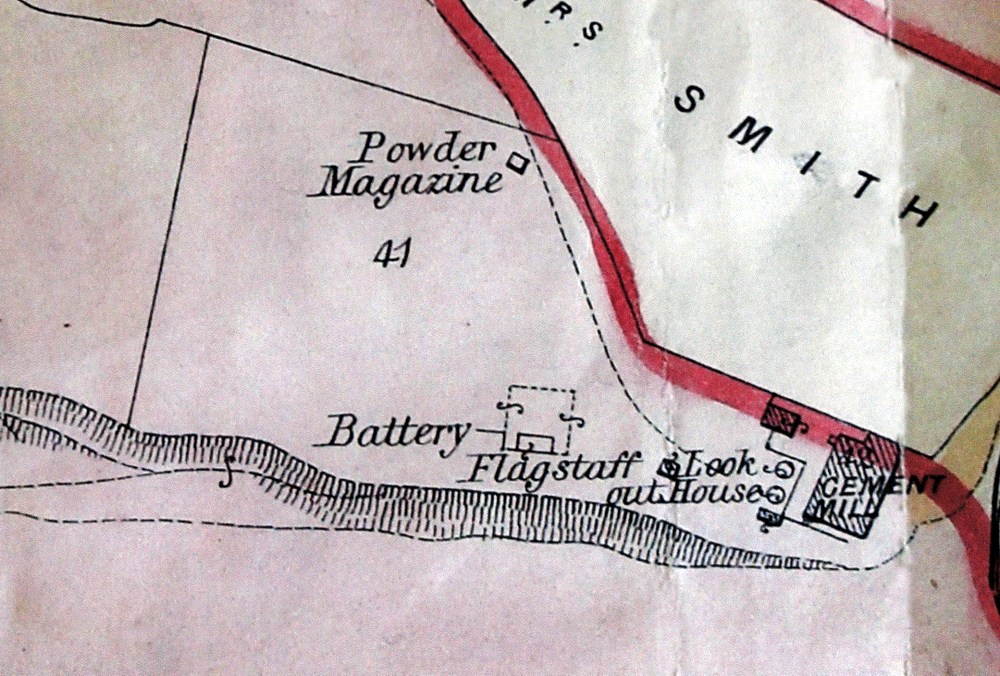

Charmouth - Lot 21 Lilly Farm, offered £3,150, reserve price - £4,000 Lot 22, about 6 acres of arable and grass lands, in the occupation of john Bull, no offer. Lot 23, a garden rented by Mr. Potter, who purchased it for £30. Lot 24, a garden in the occupation of Mr. Lugg, who purchased it for £14. Lot 25, dwelling house, occupied by Mr Thomas Parrett, offered £250, reserve price £300. Lot 26, two houses and garden let to Mr. Penny and Mr. Smith, purchaser Mr. Peach for £615. Lot 27, two cottages and garden let to Lock, Gale and Payne, offered £125, reserve for £175. Lot 28, double common, bought for £200 by Mr. Richmond. Lot 29, two closes of pasture in occupation of Mr. H.Hodges and the executors of the late Mr. G. Payne, purchased by Mr. Darby for £185. Lot 30, the Drang, let to the executors of the late Mr. G. Payne, sold for £210. Lot 31, the Manor of Langmoor, not sold; reserve price, £4,000
1867 Charmouth Manor Sale |
Description |
Tenant |
A |
R |
P |
£ |
s |
d |
|
25 |
Green Close |
Bull, J. |
|
1 |
32 |
|
|
10 |
0 |
26 |
Rhode Horn, on the Cliff |
Clarke |
2 |
3 |
33 |
|
|
|
|
27 |
Rhode Horn, on the Cliff |
Clarke |
4 |
3 |
22 |
|
|
|
|
|
total: |
|
7 |
3 |
15 |
|
10 |
0 |
0 |
29 |
Part of Rhode Horn |
Hodges, J |
2 |
3 |
18 |
|
|
|
|
30 |
Oak Close |
Hodges, J |
3 |
0 |
20 |
|
|
|
|
31 |
Ten Acres |
Hodges, J |
6 |
1 |
20 |
|
|
|
|
|
total: |
|
12 |
1 |
18 |
|
20 |
0 |
0 |
33 |
Lower Jessy Close |
G. Payne, late, Executors |
2 |
3 |
24 |
|
|
|
|
34 |
Middle Mead |
G. Payne, late, Executors |
3 |
2 |
6 |
|
|
|
|
40 |
Hammonds Mead |
G. Payne, late, Executors |
3 |
1 |
30 |
|
|
|
|
41 |
Jessy Close |
G. Payne, late, Executors |
2 |
0 |
15 |
|
|
|
|
|
total: |
|
11 |
3 |
35 |
|
36 |
0 |
0 |
42 |
Cement Mills |
Morcom, lease from 1863 |
0 |
0 |
25 |
|
|
|
|
43 |
Cliffs |
Morcom, lease from 1864 |
29 |
2 |
23 |
|
|
|
|
44 |
Foreshore |
Morcom, lease from 1865 |
25 |
0 |
0 |
|
|
|
|
|
total: |
|
54 |
3 |
8 |
|
100 |
0 |
0 |
28 |
Part of Rhode Horn |
Mrs. Moore |
1 |
0 |
14 |
|
|
|
|
32 |
Higher Jessy Close |
Mrs. Moore |
0 |
3 |
34 |
|
|
|
|
|
total: |
|
2 |
0 |
8 |
|
6 |
0 |
0 |
41 |
Battery,Look Out House |
Admiralty |
|
|
|
|
6 |
0 |
0 |
|
|||||||||
The Manor of Langmoor or Charmouth together with the Foreshore of about 25 acres |
|
|
|
|
|
|
|
|
|
between High and low Watermarks,and a valuable Cement Mill together with 64 acres |
|
|
|
|
|
|
|
|
|
of Arable and Grass Lands let for £178 per annum. |
|
|
|
|
|
|
|
|
|
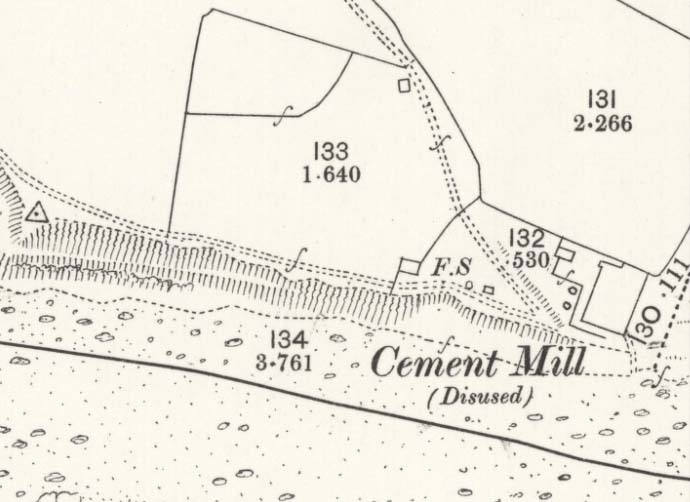
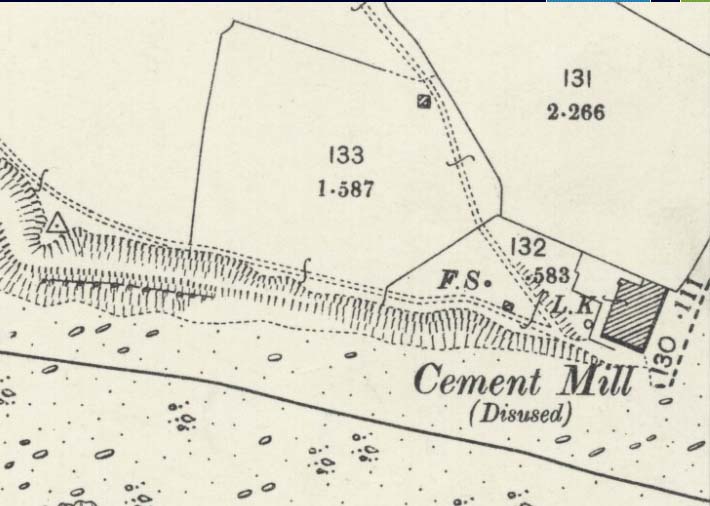
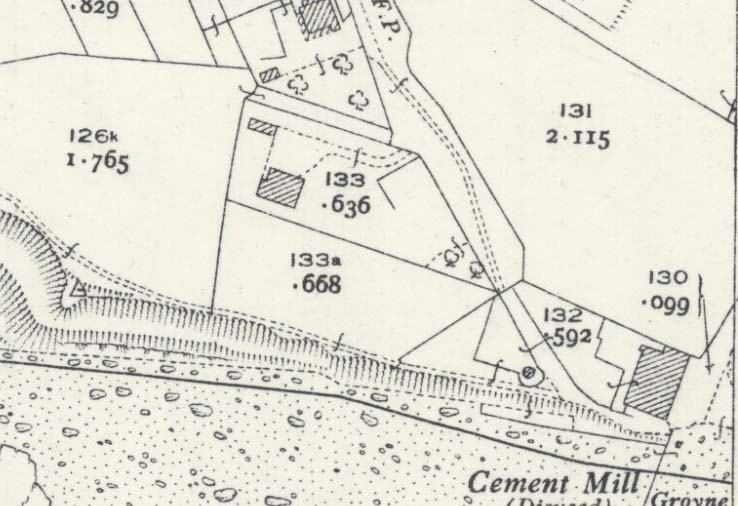
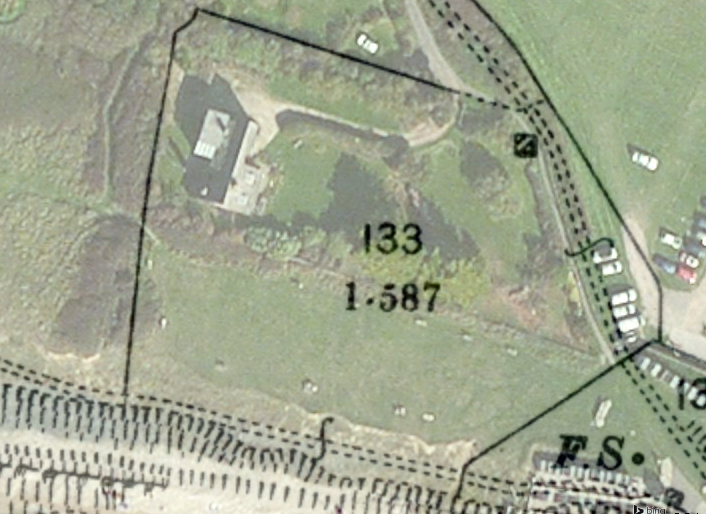
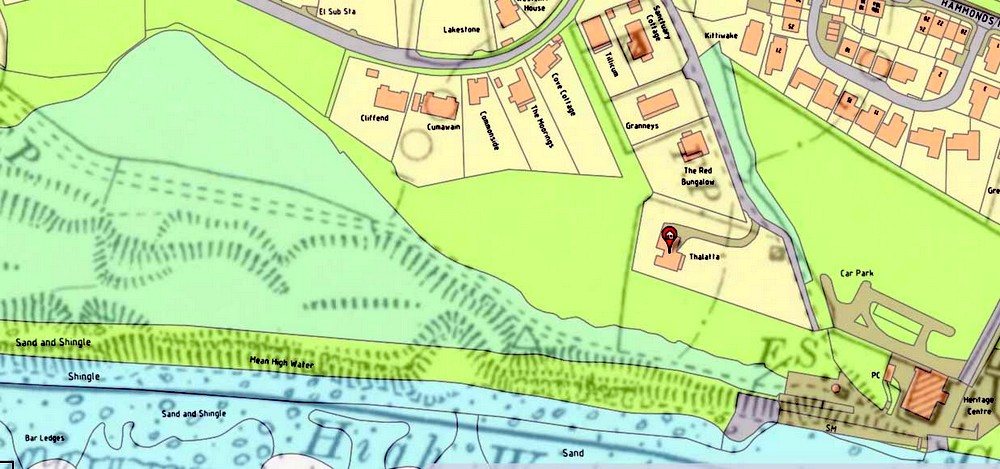
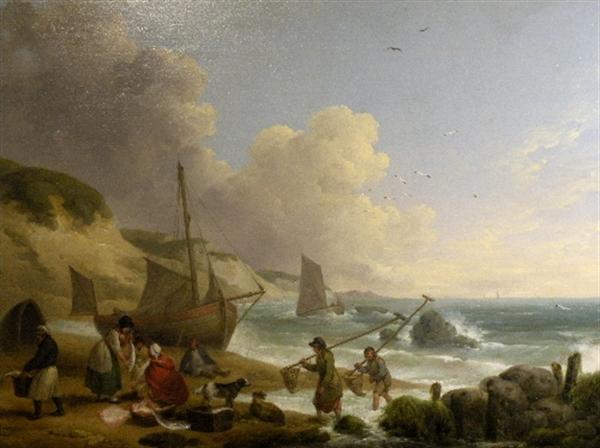
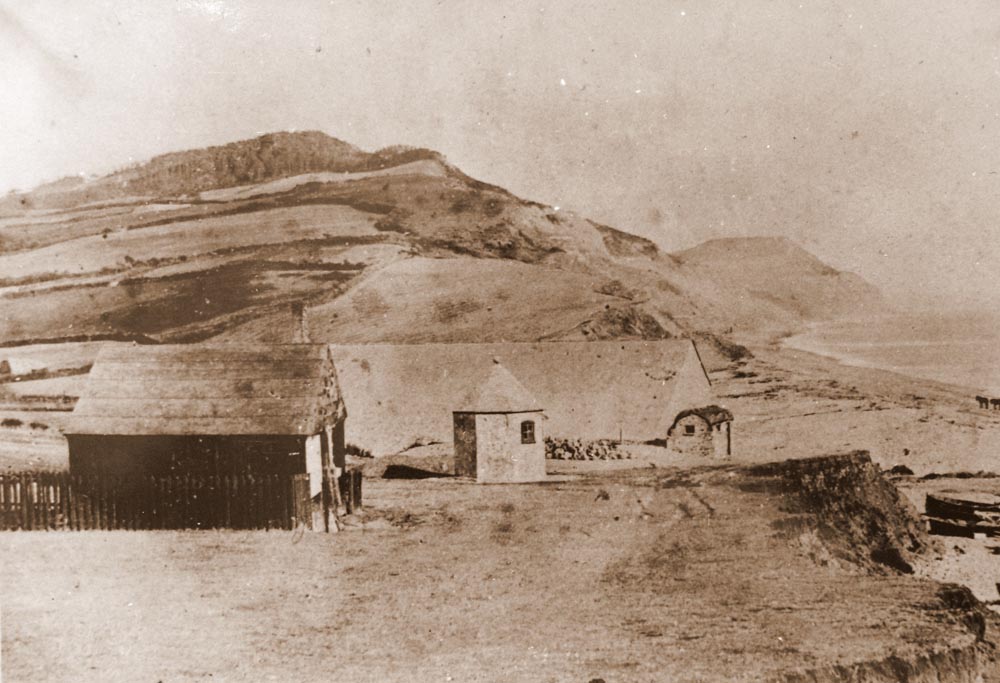
.jpg)



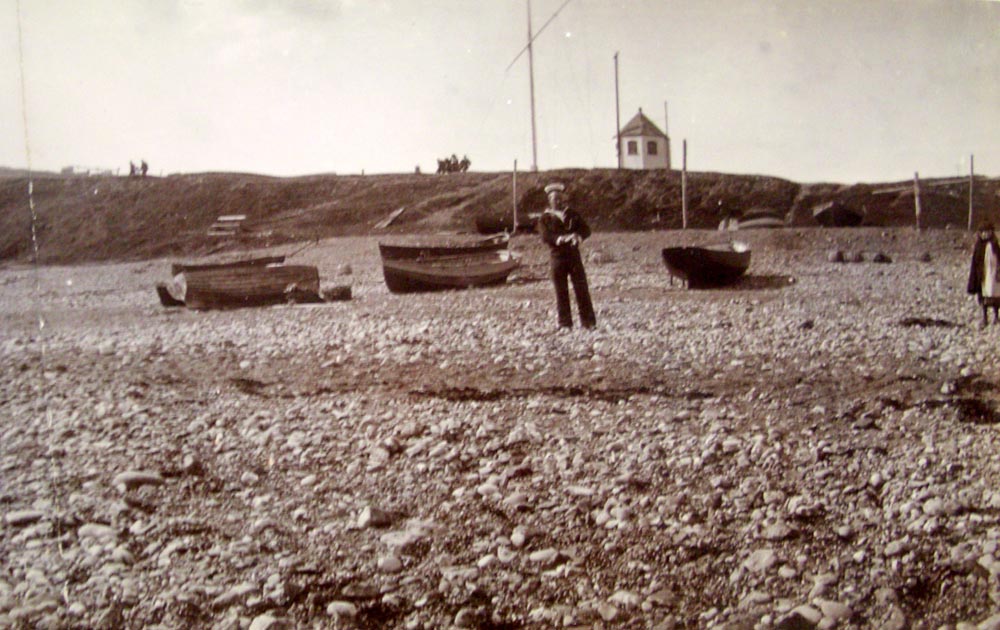

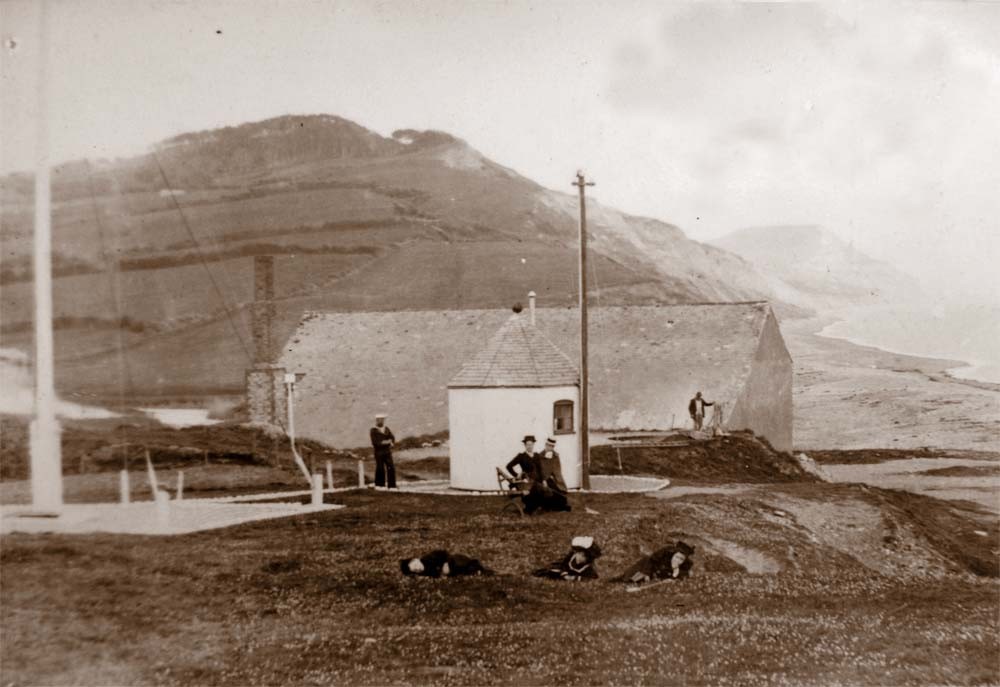
.jpg)
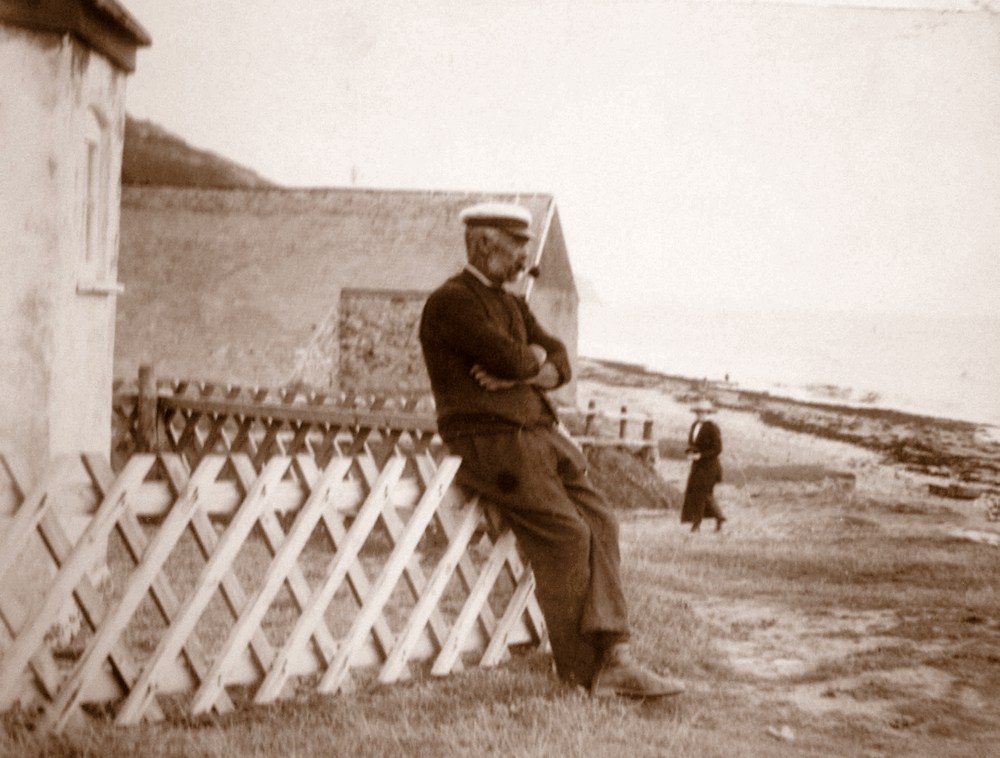
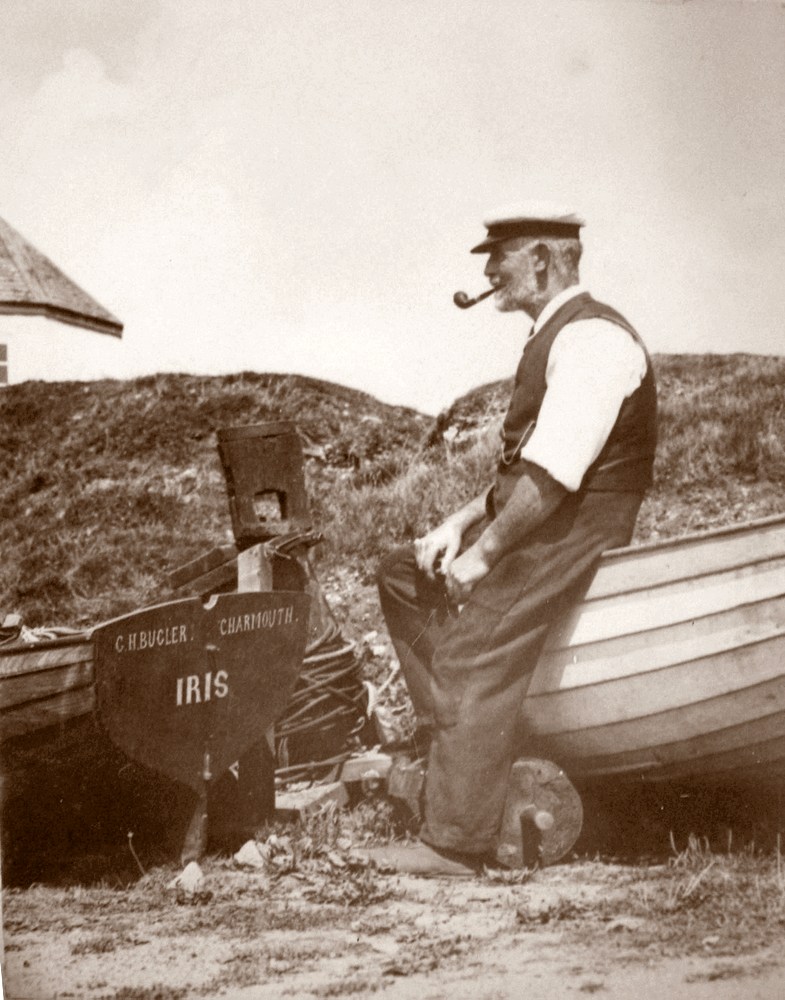
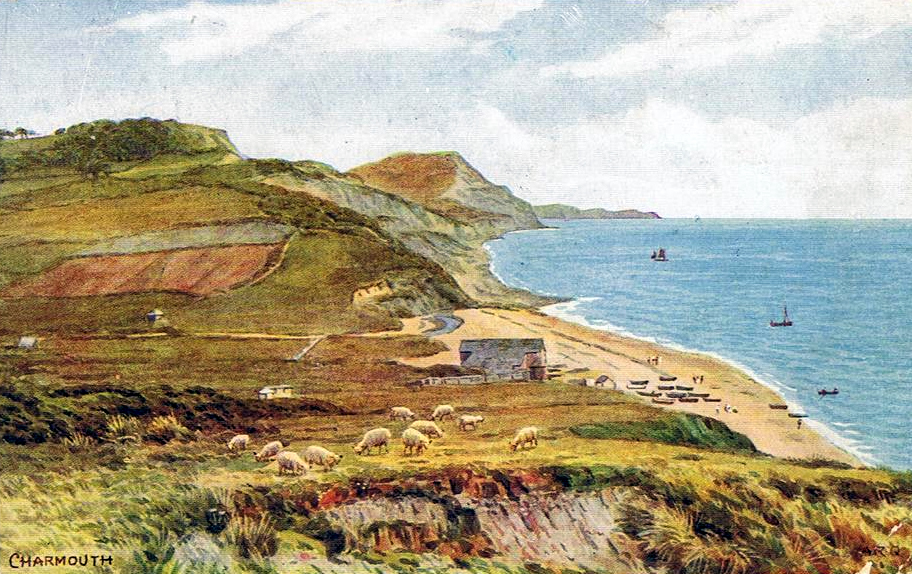
The Excise men occupied the cliff slope immediately west of the Cement Factory. Here they built the little octagonal lookout, fortunately still standing, and put up a flag-staff on a plot behind it. These were “ held at will from the 10 th of June, 1855, from Mr George Frean at £3 a year.”
With the passing of the Coast Guard Act in 1856, the Admiralty took over the establishment. The officer in charge at Charmouth was Benjamin Simpson, Master R.N., who held the appointment since the 3 rd . September 1851. His predecessor was Lieutenant Charles Partridge,R.N., appointed non the 28 th January .1847. From this it will be seen that Naval officers were filling these posts, and that there was a station at Charmouth before the actual transfer to the Admiralty took place. The title deeds of the cottages would have been transferred to the Admiralty in consequence of the Act of 1856. The earliest record at the Admiralty of the houses at Charmouth is a lease dated 17 th May 1878 for 21 years from 25 th March, 1878, made between the Admiralty and the trustees under he will of the late John Hodges at a rent of £50 a year. When this lease expired it was renewed for a further term of years from the 25 th of March 1899, at the same rent, the lessee then being Richard Hodges. The station was abolished in 1909, and was surrendered to the landlord in consideration n of the payment by the Admiralty of £150.
In 1891 the rent of the look-out house and flag-staff became payable to J.J. Coulton and an agreement was entered into on a yearly basis in 1895 at its former rent (£3 a year). The Admiralty determined the tenancy on the 29 th of September 1909.
While they were in Charmouth, the Coastguard formed a useful and attractive element in the life of the village. They were forward to lend a hand wherever they could be useful. Was bunting needed for a village festival, the Coast supplied it; they supplied the cool-headed and skilful- handed aid to guide and control the blazing tar-barrels when they careered down Charmouth Street on Guy Fawkes night; and their unofficial activities in their degree were perhaps as beneficial to the nation as their public duties were essential.
In 1801, John Oliver, Master R.N., wrote to Captain Boteler R.N,. Coastguard Station, Lyme Regis,” During the last war with France, a Privateer chased a Brig past the Town to the Westward within half a gun-shot of the batteries, when there was not a gun serviceable to defend her, and the enemy captured her near Seaton. A small battery of three guns opposite the Cobb and another at Charmouth under the direction of the Coastguard service would be very desirable in the event of war”. Perhaps this was the origin of the gun kept by the Charmouth Coastguards on the West cliff. It was kept in a shed above the Look-out house; and it used a 6lb. Shot. A target was fixed in the sea at about 300-400 yards range; and the shot was retrieved at low water and used again.
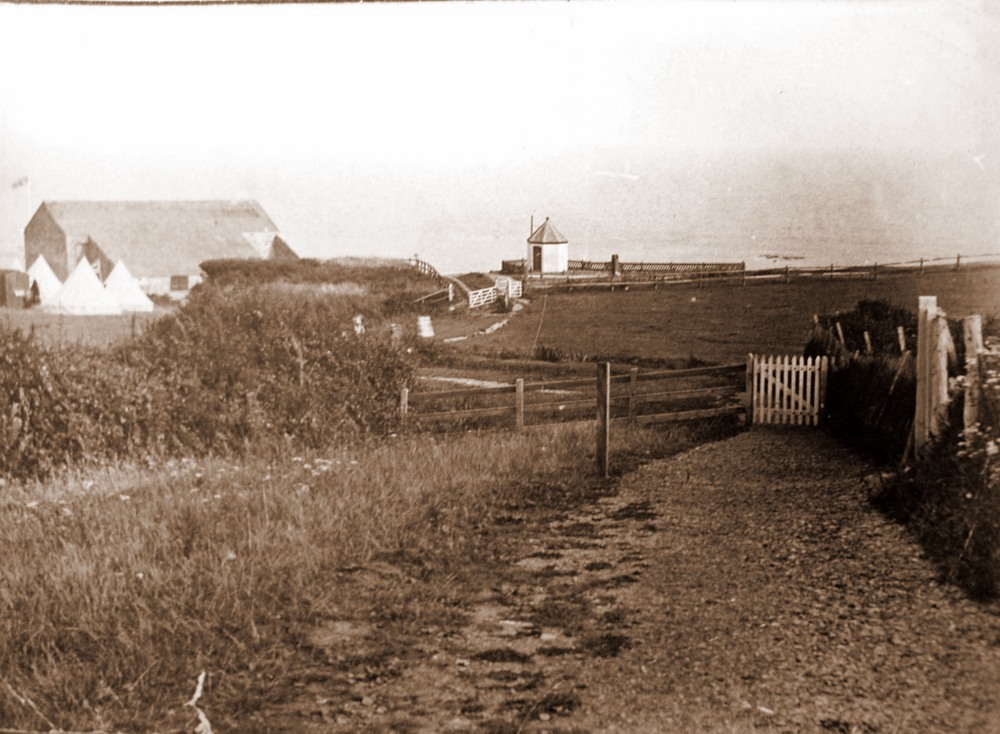
Abstract of the Title of A.D.Pass Esq. to property in the Parish of Charmouth,Dorset 1909 |
INDENTURE of this date between George Gordon Coulton of No. 40 Mill Road Eastbourne in the Coy. of Sussex Esq.M.A. Edmund Lees Coulton of Pentney in the Coy. of Norfolk Esq. Sarah Priscilla Elizabeth Coulton of Kings Lynn in the c oy. of Norfolk Spinster & Beatrice Octavia Coulton of Pentney afsd Spinster (hereinafter called "the Vendors") of the one part & Alfred Douglas Pass of Wootton Pitzpaine .Charmouth in the Co. of Dorset Esq. (hereinafter called "the Purchaser") of the other part |
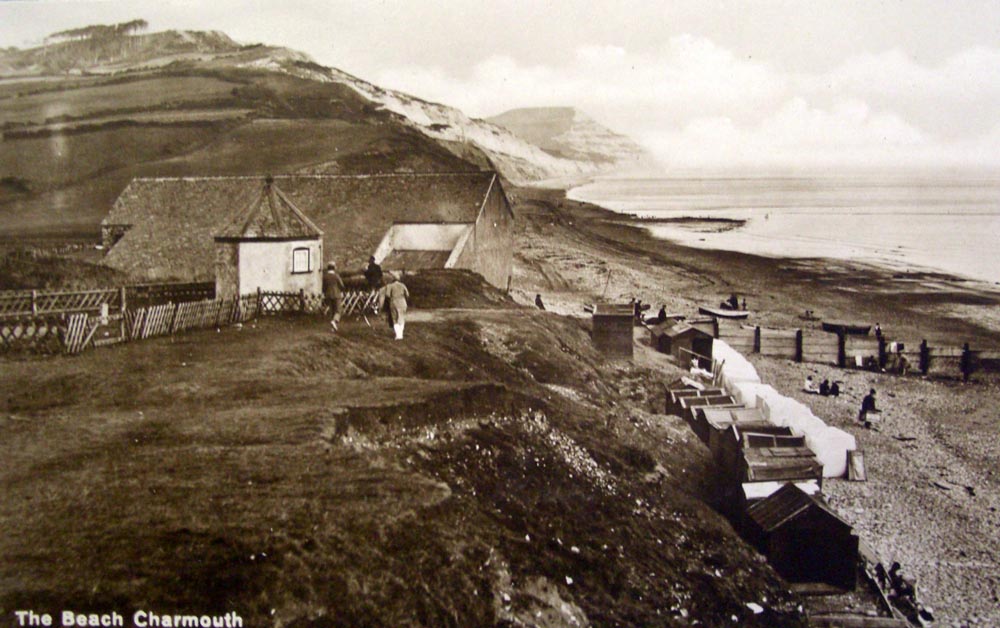


A Coastguard Family in Charmouth
When we realised that the cottage in which my family lived in the early Nineteenth Century was now available to rent as a holiday home we decided to come and see it for ourselves. This story owes its existence to the help of Ben and Jodi Dauncy the owners of the cottage, and to members of the Pavey Group, in particular Neil Mattingly who pointed us in the direction of the Pavey Archive now kept at the Dorchester Record Office, and provided us with several of the photographs. Many thanks. SB
William Brickell, my great great grandfather, was born in Dover in 1797. He did not follow in the footsteps of his pastry cook father, but became a mariner and later joined the Coastguard Service in Hastings. In 1840, he was posted to Charmouth and brought his family to live in the Coastguard Cottages in Sea Lane. Mary was his second wife and was from an oyster-fishing family in Mersea on the Essex coast. Their children Sarah, William, Louisa, Edwin and Charles were aged between 10 and 1 year old. With seven in the family the cottage would have been crowded by today’s standards; the front door opening
straight into the main room with its range and enclosed stairs up to the two bedrooms. The kitchen and bathroom are more modern additions.
The purpose of the Coastguard Service in the Nineteenth Century was much more related to the prevention of smuggling than the rescuing of people in danger at sea. There were “Preventive Officers” or “Revenue Men” based all along the South Coast, as all around the British Isles. The Dorset coast with its many remote coves and bays where boats could come ashore and unload their casks and barrels was particularly popular with those who wanted to avoid paying duties on wine, spirits or tobacco from France. Usually the Coastguards were posted to new stations every few years, apparently in order to avoid the risk of fraternising with the locals and becoming open to bribery or other temptations. William, however, remained in Charmouth for the rest of his life though his sons Edwin and Charles between them lived in Axmouth, Lyme Regis, Seatown (near Chideock), Stanton St. Gabriels and Weymouth as well as in Southsea, Dover, Hastings, and Kilkee in Ireland.
The working duties of the Coastguard were based around the Watchhouses. The contemporary Log of the Lyme watchhouse, for example, gave day-by-day details of vessels in the harbour that were suspected of being involved in smuggling and would need an eye kept on them. Copies of letters and other intelligence from the Service were also included so that the Coastguards on duty would be kept aware of suspicious activity.
The Lyme watchhouse was on the harbour next to the Cobb though others, such as Seatown and Charmouth, were smaller huts on the headlands by the beach giving a good view of shipping and other activity. Often the Coastguards’ living accommodation was also on high ground with a view. Weymouth, Portland, Chesil Beach, and Seatown cottages were all like this. Charmouths two groups of Coastguard cottages, one in The Street and the other in Sea Lane, were set back from the beach by about a quarter of a mile, though the Armoury at the Sea Lane site would enable the men to grab their weapons and get to the beach quickly in the event of an attempted arrest or an armed attack by groups of smugglers. The picture of the nearby Lulworth Coastguards (below) shows them armed with muskets and cutlasses fixed as bayonets, while the officer carries a sword. Ammunition pouches are also part of the equipment carried. As well as their personal weapons the Charmouth Coastguards were equipped with a six-pounder gun kept in the shed near the lookout. It had been originally supplied during the Napoleonic wars in case of attack by French ships. A target was set up in the sea about 400 yards offshore so that after gunnery practice the shot could be retrieved at low tide. There were certainly armed clashes with smuggling gangs during this period, and more than one coastguard lost his life along the Dorset coast. There were also more minor skirmishes. The Dorchester and Sherborne Journal recounts how on one occasion two preventive men set off at night to capture a smuggler and his horse laden with contraband. In the darkness one of the guards arrested the smuggler and the horse, but the other guard, mistaking him for the smuggler, attacked his fellow officer. The smuggler used the resulting confusion to slip quietly away-with the horse and its load. William and Mary’s family grew over the next ten years with the births of Emily, Sophia and Alice. By 1851 they had moved to the Coastguard cottages in Charmouth Street where they remained for the next twenty years. The three girls were christened at the newly-rebuilt parish church, and would have attended the village school (just up the road from the Lower Sea Lane cottage) with their elder brothers and sisters. Alice suffered all her life from rickets and died at the age of 12.Sophia later married and raised a family in London where she lived until her death in 1921. Emily remained in Charmouth working as a dressmaker. Of the older children Sarah left home to work “in service” in Torquay and later became a dressmaker in Newcastle under Lyme, Louisa returned to Hastings where she
married and had two children, while Edwin and Charles followed their father into the coastguard service. Their parents remained in Charmouth after William’s retirement. He had reached the rank of Chief Boatman in the Coastguards and in the 1871 Census he is listed as a “Coastguard Pensioner”. Mercer and Crocker’s Directory for Dorset lists him in that same year as a private resident, though spelling his name as Brickhill. Charles’ route into the Coastguard service was via the Royal Navy, serving on various Revenue Cruisers from the age of 16. In 1861 he was serving as an Able Seaman on
HMS Petrel at Lymington in Hampshire (this time the misspelling is Brickle), and served with the coast-guards themselves from 1871 to 1881 at Southsea where he had a wife and family. Having completed his ten-year coastguard service he was not allowed to re-enlist, as a further ten-year enrolment would extend beyond his retirement date at the age of 60. Accordingly he resumed his Navy service as a quartermaster. He died in the RN sick quarters at Grimsby in 1892. Charles’ elder brother Edwin had a similar career. At the time of the 1861 Census when he was 24 he was serving as an Able Seaman with the Coastguard at Portland as part of the 14-man crew aboard the two-gunner cruiser HMS Eagle, and up until 1888 when he was transferred to Ireland he served in a variety of ships and shore stations along the Dorset coast. The vessels used by the coastguard service varied in size. Cruisers ranged from 25 to 150 tons and there were also smaller boats like those in the photos of Charmouth watchhouse. The smugglers would be pursued, arrested, accompanied into port and the guilty vessel seized along with the contraband, assuming the smugglers had not managed to dispose of it in time. As a single man Edwin was moved easily from one posting to another; Axmouth, Lyme, and Chideock, while serving on HM Ships Achilles, Warrior, and Resistance. The Coastguard station at Chideock (Seatown) had a very similar outlook to that of Charmouth, with the Watch-House on the cliff above the beach and the living accommodation behind. The hamlet of Stanton St. Gabriels has since been lost to the sea, but even in the 1800s it was only a cluster of houses near the ruined church. The
ruins were said to be a favourite hiding place for smugglers to leave their cargos until they could be safely collected. Perhaps they hoped that any ghosts would keep the coastguards from investigating too closely The year 1875 was an eventful one for Edwin. In June he was married to Eliza Wilson the daughter of a shoemaker and hairdresser in Crediton. Eliza was recorded in the census four years earlier visiting a friend in lyme Regis -maybe that is how she and Edwin met. Six weeks after the wedding, however, Edwin’s mother died and he returned to Charmouth for the funeral.
Mary had suffered for many years from scrofula and a prolonged bout of diarrhoea proved too much for her. In December of the same year Edwin’s father William caught a chill and fever which led to his death. Edwin was present at the time, and brother Charles returned from Southsea for the funeral. A third tragedy struck the family just four days after William’s death when Edwin and Charles ’ sister Emily, aged 34, died of heart failure. This time Charles took the responsibility of informing the registrar in Lyme while Edwin had to arrange a double funeral. William and his daughter were buried together a few days before Christmas in the same grave where Mary had been laid just four months earlier. The memorial stone is next to the church path in St Andrew’s churchyard . The Charmouth connection did not come to an end with the triple burial; it was now Edwin and Eliza who moved into the cottage in Lower Sea Lane where he had lived as a teenager. William, Florence, Emily and Millie were born there over the next few years and christened at St Andrew ’s.
Edwins coastguard duties over this period were based at Chideock and Lyme Regis on Achilles, Warrior, and Resistance.
In 1882 Edwin was transferred to HMS Hercules at Weymouth and the family left Charmouth for the last time, moving into one of the coastguard houses near the Nothe Fort overlooking Weymouth harbour. A fifth child, Charles (my grandfather) was born there in 1885.
Edwin later became the Chief Officer at the Kilkee coastguard station in County Clare, Ireland, and eventually retired to Dover in Kent, where he died in 1904. Eliza survived him by two decades. Of his children, William was drowned in an accident in the Solway Firth (the report in The Times misspelling the name as Bricknell this time), the three girls never married, and only Charles continued the family line. Edwins` line now extends to two great great grandchildren, three great -great - great grandchildren, and three (soon to become four) great -great-great -great grandchildren.
Simon Brickell
“In memory of MARY ANN wife of WILLIAM BRICKELL who departed this life August 16th 1873 aged 65 years Also of WILLIAM BRICKELL husband of the above who died Decr 13th 1875 aged 79 years And of EMILY OVERALL BRICKELL who died Decr 16th 1875 aged 34 years “I know that my Redeemer liveth”
